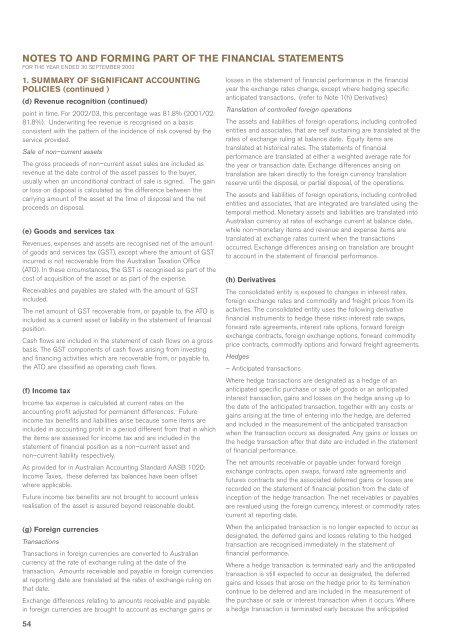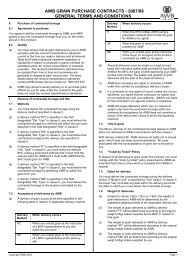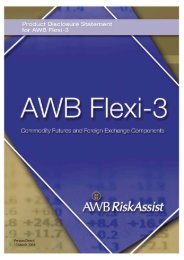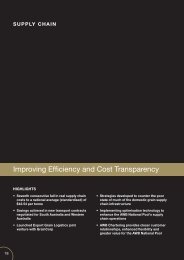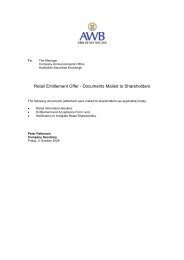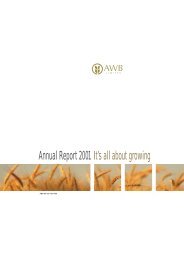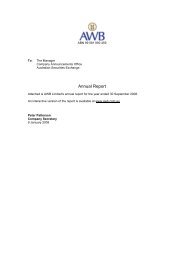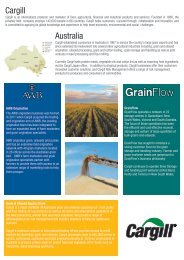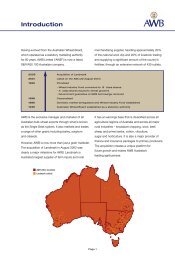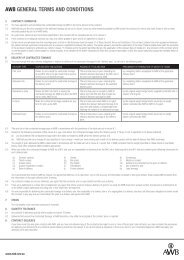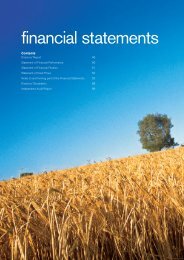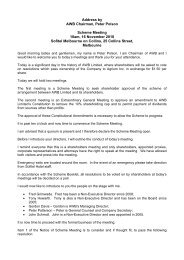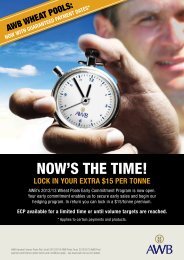AWB Limited - 2003 Annual Report
AWB Limited - 2003 Annual Report
AWB Limited - 2003 Annual Report
Create successful ePaper yourself
Turn your PDF publications into a flip-book with our unique Google optimized e-Paper software.
NOTES TO AND FORMING PART OF THE FINANCIAL STATEMENTS<br />
FOR THE YEAR ENDED 30 SEPTEMBER <strong>2003</strong><br />
1. SUMMARY OF SIGNIFICANT ACCOUNTING<br />
POLICIES (continued )<br />
(d) Revenue recognition (continued)<br />
point in time. For 2002/03, this percentage was 81.8% (2001/02:<br />
81.8%). Underwriting fee revenue is recognised on a basis<br />
consistent with the pattern of the incidence of risk covered by the<br />
service provided.<br />
Sale of non–current assets<br />
The gross proceeds of non–current asset sales are included as<br />
revenue at the date control of the asset passes to the buyer,<br />
usually when an unconditional contract of sale is signed. The gain<br />
or loss on disposal is calculated as the difference between the<br />
carrying amount of the asset at the time of disposal and the net<br />
proceeds on disposal.<br />
(e) Goods and services tax<br />
Revenues, expenses and assets are recognised net of the amount<br />
of goods and services tax (GST), except where the amount of GST<br />
incurred is not recoverable from the Australian Taxation Office<br />
(ATO). In these circumstances, the GST is recognised as part of the<br />
cost of acquisition of the asset or as part of the expense.<br />
Receivables and payables are stated with the amount of GST<br />
included.<br />
The net amount of GST recoverable from, or payable to, the ATO is<br />
included as a current asset or liability in the statement of financial<br />
position.<br />
Cash flows are included in the statement of cash flows on a gross<br />
basis. The GST components of cash flows arising from investing<br />
and financing activities which are recoverable from, or payable to,<br />
the ATO are classified as operating cash flows.<br />
(f) Income tax<br />
Income tax expense is calculated at current rates on the<br />
accounting profit adjusted for permanent differences. Future<br />
income tax benefits and liabilities arise because some items are<br />
included in accounting profit in a period different from that in which<br />
the items are assessed for income tax and are included in the<br />
statement of financial position as a non–current asset and<br />
non–current liability respectively.<br />
As provided for in Australian Accounting Standard AASB 1020:<br />
Income Taxes, these deferred tax balances have been offset<br />
where applicable.<br />
Future income tax benefits are not brought to account unless<br />
realisation of the asset is assured beyond reasonable doubt.<br />
(g) Foreign currencies<br />
Transactions<br />
Transactions in foreign currencies are converted to Australian<br />
currency at the rate of exchange ruling at the date of the<br />
transaction. Amounts receivable and payable in foreign currencies<br />
at reporting date are translated at the rates of exchange ruling on<br />
that date.<br />
Exchange differences relating to amounts receivable and payable<br />
in foreign currencies are brought to account as exchange gains or<br />
54<br />
losses in the statement of financial performance in the financial<br />
year the exchange rates change, except where hedging specific<br />
anticipated transactions. (refer to Note 1(h) Derivatives)<br />
Translation of controlled foreign operations<br />
The assets and liabilities of foreign operations, including controlled<br />
entities and associates, that are self sustaining are translated at the<br />
rates of exchange ruling at balance date. Equity items are<br />
translated at historical rates. The statements of financial<br />
performance are translated at either a weighted average rate for<br />
the year or transaction date. Exchange differences arising on<br />
translation are taken directly to the foreign currency translation<br />
reserve until the disposal, or partial disposal, of the operations.<br />
The assets and liabilities of foreign operations, including controlled<br />
entities and associates, that are integrated are translated using the<br />
temporal method. Monetary assets and liabilities are translated into<br />
Australian currency at rates of exchange current at balance date,<br />
while non–monetary items and revenue and expense items are<br />
translated at exchange rates current when the transactions<br />
occurred. Exchange differences arising on translation are brought<br />
to account in the statement of financial performance.<br />
(h) Derivatives<br />
The consolidated entity is exposed to changes in interest rates,<br />
foreign exchange rates and commodity and freight prices from its<br />
activities. The consolidated entity uses the following derivative<br />
financial instruments to hedge these risks: interest rate swaps,<br />
forward rate agreements, interest rate options, forward foreign<br />
exchange contracts, foreign exchange options, forward commodity<br />
price contracts, commodity options and forward freight agreements.<br />
Hedges<br />
– Anticipated transactions<br />
Where hedge transactions are designated as a hedge of an<br />
anticipated specific purchase or sale of goods or an anticipated<br />
interest transaction, gains and losses on the hedge arising up to<br />
the date of the anticipated transaction, together with any costs or<br />
gains arising at the time of entering into the hedge, are deferred<br />
and included in the measurement of the anticipated transaction<br />
when the transaction occurs as designated. Any gains or losses on<br />
the hedge transaction after that date are included in the statement<br />
of financial performance.<br />
The net amounts receivable or payable under forward foreign<br />
exchange contracts, open swaps, forward rate agreements and<br />
futures contracts and the associated deferred gains or losses are<br />
recorded on the statement of financial position from the date of<br />
inception of the hedge transaction. The net receivables or payables<br />
are revalued using the foreign currency, interest or commodity rates<br />
current at reporting date.<br />
When the anticipated transaction is no longer expected to occur as<br />
designated, the deferred gains and losses relating to the hedged<br />
transaction are recognised immediately in the statement of<br />
financial performance.<br />
Where a hedge transaction is terminated early and the anticipated<br />
transaction is still expected to occur as designated, the deferred<br />
gains and losses that arose on the hedge prior to its termination<br />
continue to be deferred and are included in the measurement of<br />
the purchase or sale or interest transaction when it occurs. Where<br />
a hedge transaction is terminated early because the anticipated


